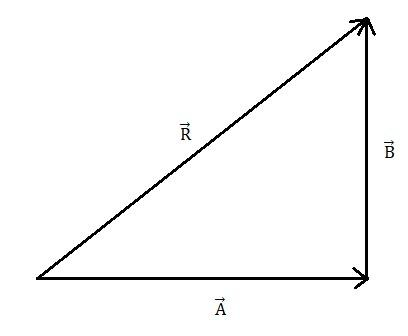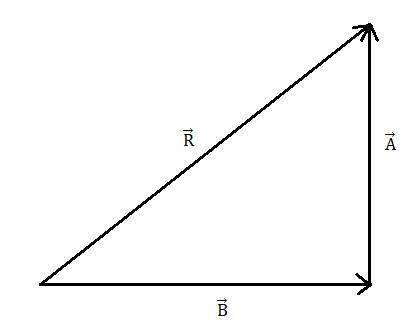
Assertion: Vector addition of two vectors A and B is commutative.
Reason:
\[\begin{array}{*{20}{c}}
{\overrightarrow A + \overrightarrow B }& = &{\overrightarrow B + \overrightarrow A }
\end{array}\]
A) Both assertion and reason are correct and the reason is the correct explanation for the assertion.
B) Both assertion and reason are correct but Reason is not the correct explanation for the assertion.
C) Assertion is correct but Reason is incorrect.
D) Both assertion and reason are incorrect.
Answer
204.9k+ views
Hint:
In this question, we have given that the vectors A and B are commutative and according to the commutative law, if two vectors are added in any order, then the resultant of those vectors will be the same. And we will determine the addition of two vectors that are to be added in any order. And then we will select the correct answer from the given options.
Complete step by step solution:
Let us assume that there are two vectors \[\overrightarrow A \]and \[\overrightarrow B \]. And \[\overrightarrow R \] is the resultant vector. therefore, we will add these two vectors using the triangle law of vector addition.
The Triangle law of vector addition says that if two vectors show the side of the triangle, then the third side of the triangle shows the resultant of the vector having the magnitude and the direction.
Now we will add the vector \[\overrightarrow A \] and \[\overrightarrow B \]. Therefore, we will get

Figure 1
From figure - 1, we can write
\[ \Rightarrow \begin{array}{*{20}{c}}
{\overrightarrow R }& = &{\overrightarrow A + \overrightarrow B }
\end{array}\]……….. (1)
And when we will add the vector \[\overrightarrow B \]and \[\overrightarrow A \], then we will get

Figure 2
From figure - 2, we will get
\[ \Rightarrow \begin{array}{*{20}{c}}
{\overrightarrow R }& = &{\overrightarrow B + \overrightarrow A }
\end{array}\] ……………… (2)
Now from the equation (1) and (2), we will get
\[ \Rightarrow \begin{array}{*{20}{c}}
{\overrightarrow A + \overrightarrow B }& = &{\overrightarrow B + \overrightarrow A }
\end{array}\]
Therefore, the assertion is correct and the reason is also correct. But the reason is not the correct clarification for the assertion.
Therefore, the correct option is B.
Note:
In this question, we have given that the vector addition of the two vectors is commutative. Therefore, it is important to note that if the addition of the vector is done in any order then, the resultant of the addition of two vectors is the same.
In this question, we have given that the vectors A and B are commutative and according to the commutative law, if two vectors are added in any order, then the resultant of those vectors will be the same. And we will determine the addition of two vectors that are to be added in any order. And then we will select the correct answer from the given options.
Complete step by step solution:
Let us assume that there are two vectors \[\overrightarrow A \]and \[\overrightarrow B \]. And \[\overrightarrow R \] is the resultant vector. therefore, we will add these two vectors using the triangle law of vector addition.
The Triangle law of vector addition says that if two vectors show the side of the triangle, then the third side of the triangle shows the resultant of the vector having the magnitude and the direction.
Now we will add the vector \[\overrightarrow A \] and \[\overrightarrow B \]. Therefore, we will get

Figure 1
From figure - 1, we can write
\[ \Rightarrow \begin{array}{*{20}{c}}
{\overrightarrow R }& = &{\overrightarrow A + \overrightarrow B }
\end{array}\]……….. (1)
And when we will add the vector \[\overrightarrow B \]and \[\overrightarrow A \], then we will get

Figure 2
From figure - 2, we will get
\[ \Rightarrow \begin{array}{*{20}{c}}
{\overrightarrow R }& = &{\overrightarrow B + \overrightarrow A }
\end{array}\] ……………… (2)
Now from the equation (1) and (2), we will get
\[ \Rightarrow \begin{array}{*{20}{c}}
{\overrightarrow A + \overrightarrow B }& = &{\overrightarrow B + \overrightarrow A }
\end{array}\]
Therefore, the assertion is correct and the reason is also correct. But the reason is not the correct clarification for the assertion.
Therefore, the correct option is B.
Note:
In this question, we have given that the vector addition of the two vectors is commutative. Therefore, it is important to note that if the addition of the vector is done in any order then, the resultant of the addition of two vectors is the same.
Recently Updated Pages
JEE Main Candidate Login 2026 and Registration Portal | Form Access

Household Electricity Important Concepts and Tips for JEE

JEE Main 2023 (January 31st Shift 1) Physics Question Paper with Answer Key

Clemmensen and Wolff Kishner Reduction - Important Concepts and Tips for JEE

JEE Main Maths Paper Pattern 2026: Marking Scheme & Sections

JEE Main 2023 (April 11th Shift 2) Physics Question Paper with Answer Key

Trending doubts
JEE Main 2025 Session 2: Application Form (Out), Exam Dates (Released), Eligibility, & More

Atomic Structure: Definition, Models, and Examples

Angle of Deviation in a Prism – Formula, Diagram & Applications

Hybridisation in Chemistry – Concept, Types & Applications

Collision: Meaning, Types & Examples in Physics

Equation of Trajectory in Projectile Motion: Derivation & Proof

Other Pages
Units And Measurements Class 11 Physics Chapter 1 CBSE Notes - 2025-26

Motion in a Straight Line Class 11 Physics Chapter 2 CBSE Notes - 2025-26

NCERT Solutions for Class 11 Physics Chapter 7 Gravitation 2025-26

JEE Advanced Marks vs Ranks 2025: Understanding Category-wise Qualifying Marks and Previous Year Cut-offs

JEE Advanced 2025: Dates, Registration, Syllabus, Eligibility Criteria and More

NCERT Solutions For Class 11 Physics Chapter 8 Mechanical Properties Of Solids




